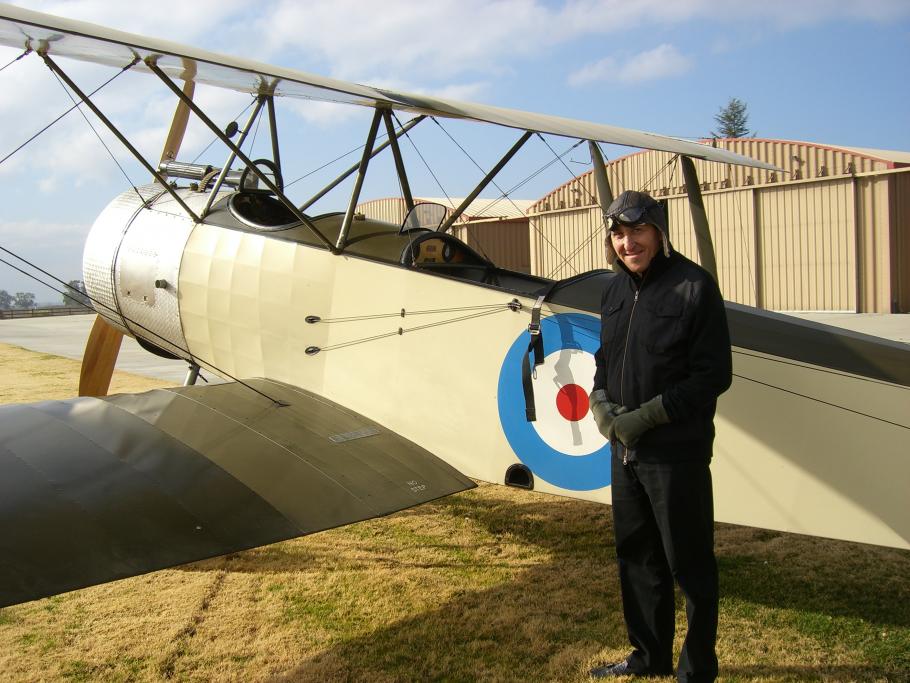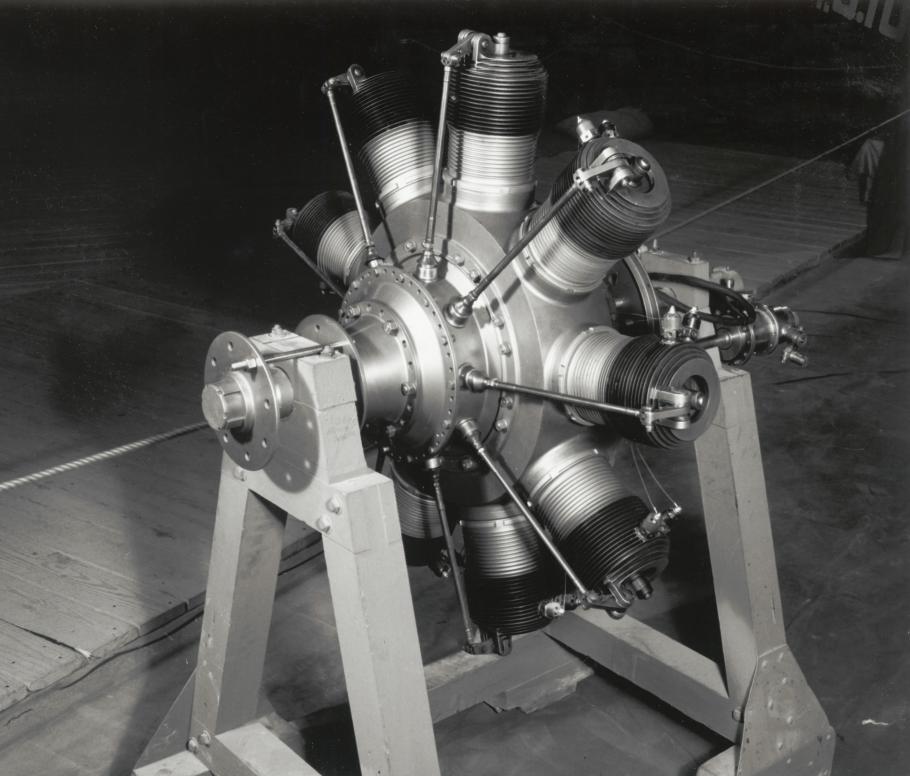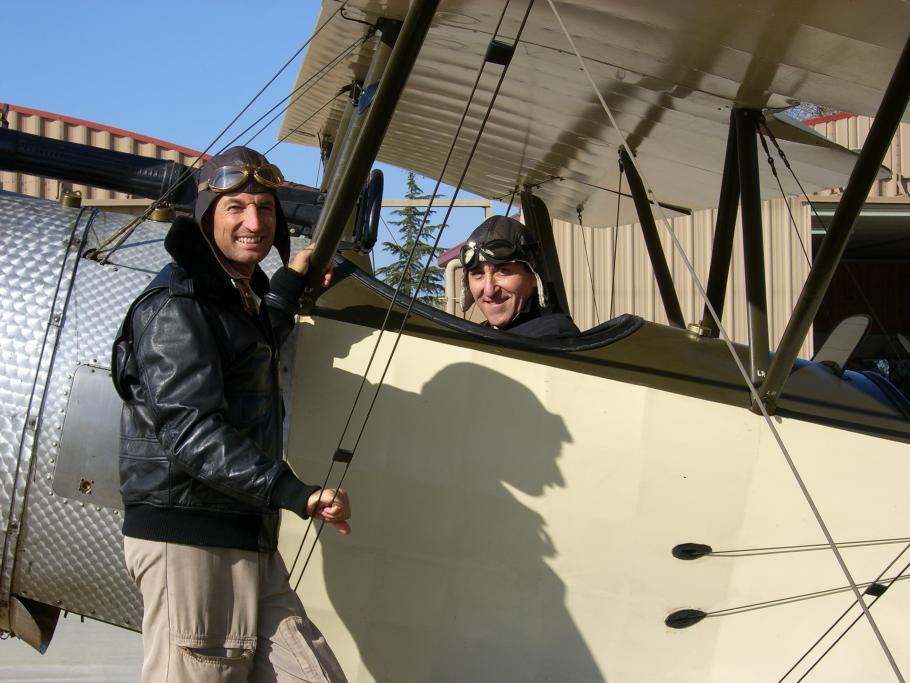For those of us who study the very early history of the airplane, the sight and sound of a World War I rotary engine running is a thrill that leaves a lasting impression. To fly in a rotary powered World War I airplane is a transformative experience. A few weeks ago I was transformed. I had the opportunity to fly in a Sopwith 1 ½ Strutter, a First World War British two-seater, powered by an original Gnome rotary engine. I’m still giddy over having flown a rotary engine powered airplane, and everyone at the Museum is jealous, including our Director, General Dailey, one of the most experienced pilots I know.
The rotary aircraft engine was an imaginative design that emerged just after the birth of flight, was the power plant for many of the most famous aircraft in the pioneer era through World War I, and was obsolete by 1920. Most engines, be they in-line, V-arrangement, or radial (cylinders in star orientation around the crankcase) have a rotating crankshaft to which the pistons are connected that transform the combustion of fuel and air into mechanical output, which in turn spins the propeller. With a rotary engine, the design concept was reversed. The crankshaft was stationary, attached to the airframe, and the rest of the entire engine, propeller attached, spun. The design had two principal advantages. First, the spinning cylinders provided excellent cooling to the engine. Second, the rotary configuration offered a good power output to weight ratio. These early power plants produced relatively low horsepower, so weight was a critical factor in the overall performance of the engine. The rotaries had major drawbacks, such as the shedding of cylinders from the spinning engine and a tendency to catch fire. But in the early days of aviation these hazards were outweighed by the relatively good power output for the engine’s weight. By the 1920s, equal and better performance was achieved with stationary cylinder engines and the rotary quickly disappeared from the scene.
Gnome 9N Rotary, 160 horsepower
The rotary engine was an interesting technological design, but it has acquired an interesting cultural status among those drawn to the early years of flight as well. It had a unique sound because the engine typically ran at full power or was off, producing a seemingly alarming rhythm to the uninitiated. Its castor oil lubricant, spewing effusively from the spinning cylinders, produced a distinctive odor. There was the pronounced torque of the whirling engine and propeller combination affecting the stability of the airplane. All these characteristics, unique to the short-lived rotary engine, made it famous, and are coveted to experience by any modern enthusiast of World War I aviation. Today, there are few places where these near-century old engines come to life. There are a handful of flying aircraft museums that occasionally fly airplanes with rotaries for the public, and there is a small number of private vintage aircraft owners who take to the air behind these amazing engines. I was fortunate to grow up not far from one these special settings where rotary powered airplanes regularly flew—the Old Rhinebeck Aerodrome Museum near Poughkeepsie, New York. Beginning as a teenager in the 1970s, I would frequent the Aerodrome often to watch the air shows and talk with the pilots. It was where my love of early aviation took hold. Over the years, no matter how many times I saw, heard, and yes, smelled, the rotary engines flying up at Old Rhinebeck, I was always captivated. Since that time, one of the experiences at the very top of my curatorial bucket list has been to fly in a rotary engine powered World War I airplane. This past December, after nearly three decades of curating the early history of the airplane at the National Air and Space Museum, I was fortunate and privileged to have crossed this off my list.
A supporter and great friend to the Museum, who has a personal collection of more than two dozen flying World War I airplanes, invited me to his home and private airfield to treat me to a flying experience of a lifetime. He knew of my longtime desire to fly in one of these airplanes that I have so passionately studied, and we talked about doing it for a couple of years. In December, the circumstances were right, the weather was good, and the opportunity finally arrived. Most of the aircraft in his collection are reproduction airframes, but nearly all have original World War I engines. Lucky for me, one of these airplanes is a two-seater—a Sopwith 1 ½ Strutter. On a crisp and clear Sunday morning, we pulled up to the airfield. There, sitting out on the grass strip, with no evidence of the 21st century in sight, just like it was 1916, was the airplane ready to be propped. After donning the traditional leather flying helmet and goggles we climbed into the Sopwith, and then the moment came. The Gnome rotary roared to life. After a brief taxi to get into take-off position, the engine was brought to full power and in just a short distance we were airborne. My host circled around the field a few times and then he signaled it was my turn at the controls. I couldn’t believe it. Here I was actually flying a World War I rotary engine powered biplane. The sound, the feel of the controls, the open cockpit—all the things I had read about and studied were now part of my personal experience. After a few more minutes of pure flying joy, we landed. Out of the airplane we discussed our “mission” as pilots always do, with smiles on our faces. It was a truly remarkable experience for me. The next time I lecture at the Museum about World War I flying, more so than ever before, I will feel confident that I know what I am talking about. I’ve done it.



